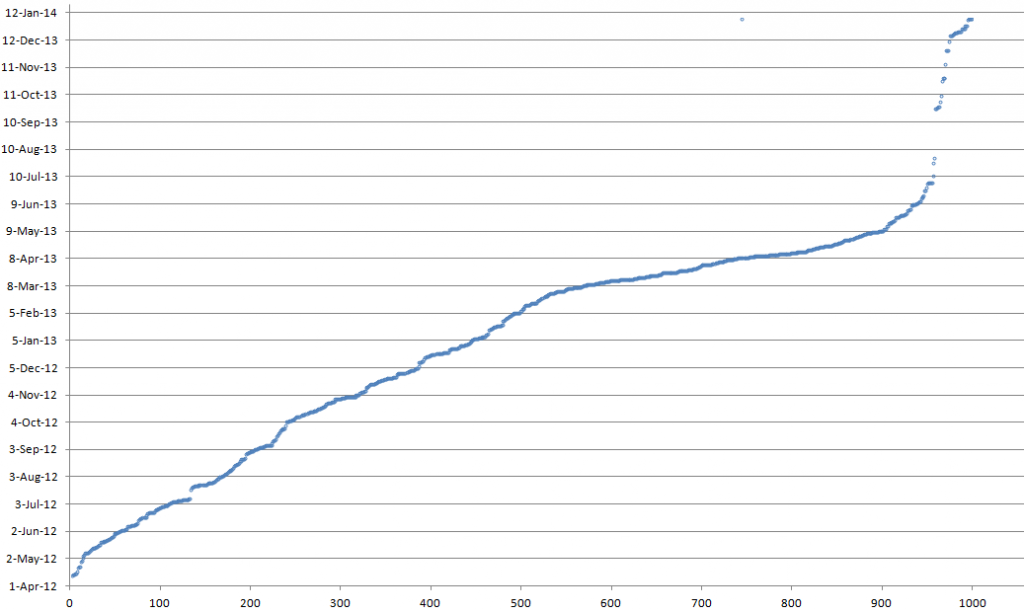Obsess much?
- January 9th, 2014, 9:56 PM
- Posted in gaming . general . graphics
- Write comment
So for … basically ever, I’ve been playing a simple logic “solitaire” game called Sherlock. Its pretty simple, has only a few rules to understand, and it is in a class of game that I have just basically always had in my life in one form or another. I have read a few studies over the years that indicate that keeping your brain engaged and active can either prevent or delay the onset of some of the cognitive disoders, like Alzheimer’s. Not that I originally considered that in my choice to play these sorts of things, I just liked them. And still do… but it has certainly reinforced my decision to continue playing them. They are a sort of litmus test for whether or not I’m “slipping” mentally, or losing my ability to solve those sorts of problems. There are certainly lots of arguments that I’m not doing a very scientific test. Yes, sure… granted. But that also isn’t my primary goal. Its just a happy side effect.
Anyway.
Yesterday, I played it again, and realized that in this go ’round, I had just hit game ‘1000’. I used to just play a random level and it would choose one of the 32000+ levels (or more??) that the game has. But last time I reinstalled, I decided to just start at puzzle 1 and go forward from there. I’m fairly sure that it just uses the level number to seed the game’s generator engine (or whatever), so it isn’t like there is any progression in difficulty. The main “difficulty” setting is how many “hints” you tell it to give you up front, and I basically just always dial that down to zero. But the clues each puzzle provides are *always* enough to solve every single puzzle, assuming you know the rules and can apply the relevant logic to it. When you solve a puzzle, it logs a few statistics into the log, how long it took to solve, how many clicks you used, and how many hints, notifies and sorts you used (minor ways to “cheat” or shorten your time). Again, I never use any of those. So I decided to see, over the several years of data I had now collected, if there were any patterns to emerge. Those graphs appear below.
This first one is a measure of what pace I’ve played the games over the past few years. Puzzle 1 was sometime in April of 2012, and 1000 was just a few days ago. As you can see, the pace was pretty steady right up until about June of this past year, and then slowed down pretty considerably for the remainder of the period. No real thoughts or revelations there. I either got bored of it, or had other games to play, or was just busy. The part I find most interesting about this one was just how consistent I was for more than a year. I don’t consider myself this consistent about *anything*, let alone a solitaire game.

This one is a bit more interesting, stastically anyway. The game generates a somewhat arbitrary “score” for you, based on the aforementioned metrics. The “0” values (all the way on the left) are games, well… basically, that I fell asleep during. The times posted (you’ll see this in upcoming graphs too), sometimes exceed HOURS. Most of the played games, however, all fall in that nice splotch on the right within a reasonable range. I also find it interesting that really, my ability to achieve certain scores hasn’t really changed much over time. I didn’t magically find some super logic thing that suddenly let me solve the puzzles faster or better over time. Maybe this means that I haven’t really learned anything new, and that I’m still just engaging the same techniques over time. I would, however, argue that my method is consistent and rarely gets me hung up to where I spend inordinate time “stuck”. It just really doesn’t happen.

This one (and the next) are also, statistically speaking, very similar to the last. This one is solve time, with “seconds” being along the X axis. Shortest time down there is 145 seconds. Most values fall into the range up to about 720 seconds, with all the outliers going up from there. I do think I excluded the highest values here, again, mostly because they are statistically insignificant, and they only really prove that I sometimes use my computer long beyond when I should really just have my head on a pillow.

And finally, this one. “Clicks to solve” on each puzzle. Again, statistically very similar, with most values falling nicely into that middle “cloud” of points there, not really changing much over time. Once again, really only showing that my method for solving and logic used hasn’t really changed much over time.
Geek out much? Yes, yes… I do.

